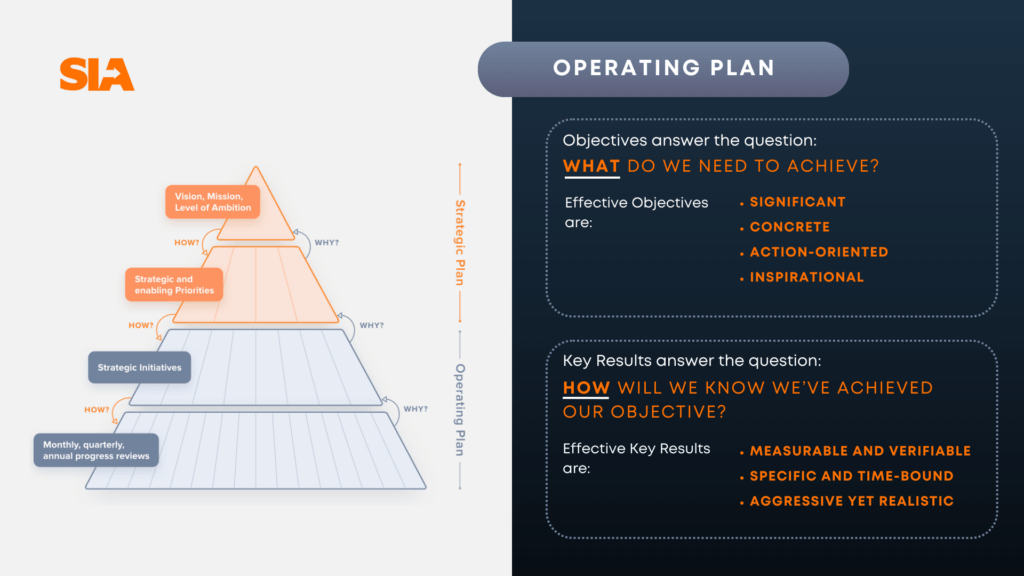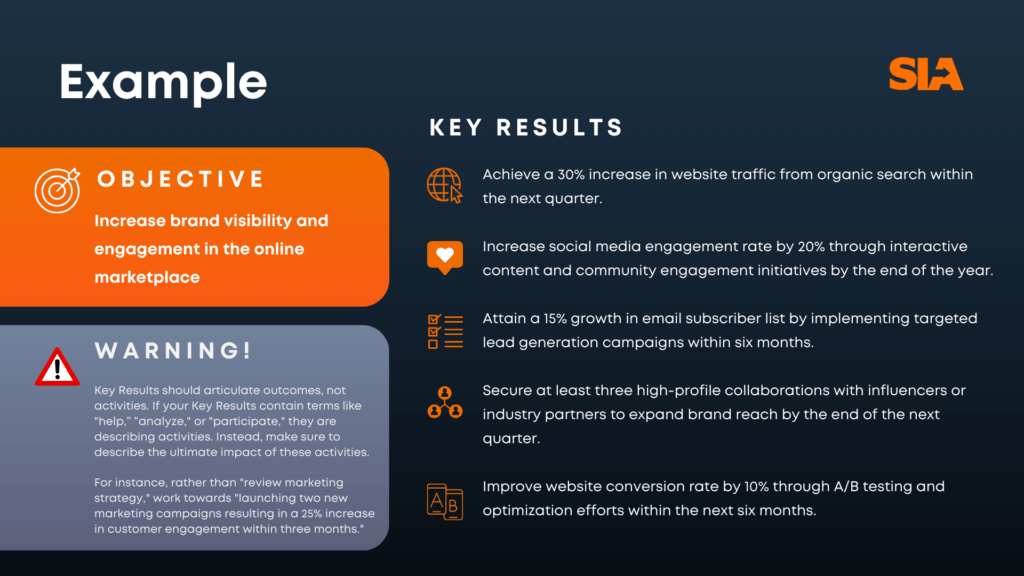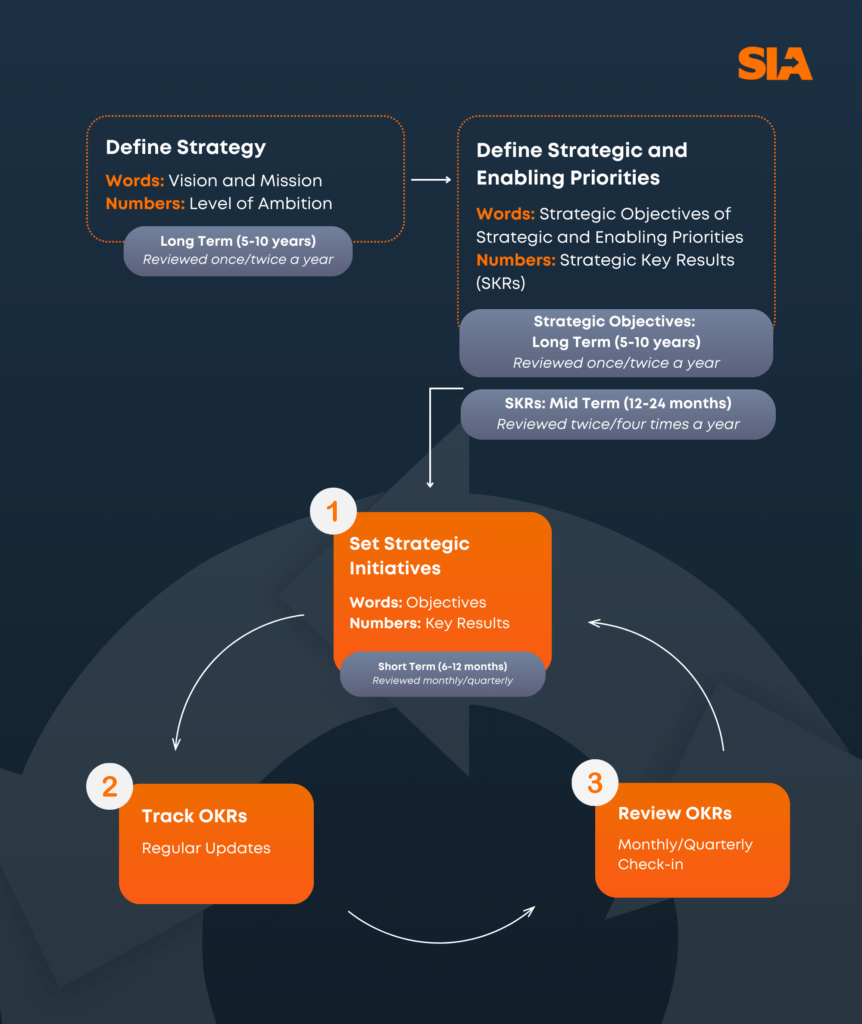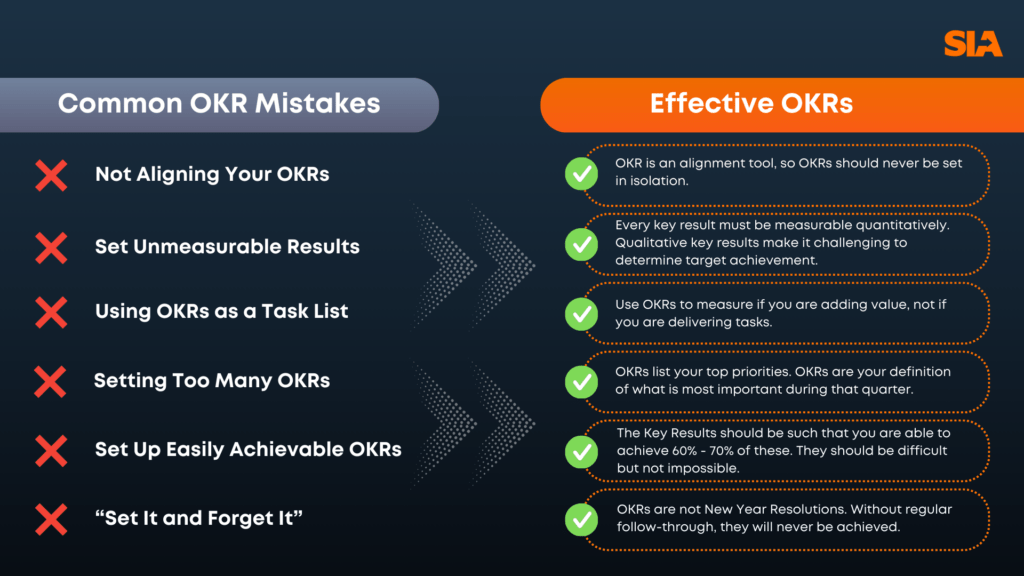
A successful business strategy is as much a matter of coming up with brilliant ideas on how to win as it is of knowing how to put those ideas into action to actually win. As Larry Page, Google Co-founder, put it, “As much as I hate process, good ideas with great execution are how you make magic. And that’s where OKRs come in.”[i]
The Genesis of OKRs
The acronym OKRs stands for Objectives and Key Results and it refers to a goal-setting framework that helps organizations align efforts and track progress towards the implementation of their strategic priorities.
The question of how to improve organizational performance has long been a concern for business leaders. A pivotal moment in addressing this question occurred in 1954 when Peter Drucker, a renowned management consultant and educator, published his book The Practice of Management, introducing the influential concept of “management by objectives” (MBO).[ii]
In the 1970s, Drucker’s emphasis on setting clear objectives and promoting alignment within an organization inspired Andy Grove during his tenure at Intel. To align efforts and measure success in the rapidly evolving semiconductor industry, Grove introduced OKRs, making them “Intel’s lifeblood.” [iii]
John Doerr, a young executive at Intel, was deeply influenced by this approach. Upon joining venture capital firm Kleiner Perkins, he introduced OKRs to a portfolio company—Google. Google’s remarkable success significantly contributed to the widespread adoption of OKRs in the tech industry. Today, organizations across a variety of sectors have successfully implemented OKRs, highlighting their versatility and effectiveness in driving organizational success.
Defining OKRs
True to their name, OKRs comprise two essential elements: Objectives and Key Results.
An Objective is a clear, directional description of WHAT is to be achieved. It should be significant, concrete, action oriented, and inspirational. Objectives are defined with words, using simple and unambiguous language.
The Key Results, on the other hand, are quantitative metrics that measure and monitor HOW to get to the objective. Key Results should be easy to measure frequently, specific and time-bound, aggressive yet realistic. In other words, they should be ambitious enough to push your team to strive for excellence, yet realistic enough to be achievable.
While Objectives may endure over extended periods, potentially spanning a year or more, Key Results adapt and develop as work unfolds. The completion of all key results signals that the objective has been achieved.
By defining clear Objectives and measurable Key Results, OKRs provide a roadmap for strategy execution. They bridge the gap between strategy formulation and day-to-day operations, translating high-level strategic priorities into actionable initiatives. This ensures that every team and individual in the organization understands their role in achieving the strategic priorities and is actively working towards them.
Moreover, OKRs promote transparency, sense of ownership and accountability. By setting clear expectations and tracking progress regularly, OKRs make it easy to identify where things are going well and where improvements are needed. This fosters a culture of continuous improvement, driving the organization towards its strategic goals.


The OKR Governance and Lifecycle: Setting, Tracking, and Reviewing
The lifecycle of OKRs involves three crucial stages for the effectiveness of the system: setting, tracking, and reviewing.
Setting OKRs involves defining clear, measurable, and ambitious Objectives and Key Results. This process should be collaborative, involving all team members, to ensure buy-in and commitment. A key rule in this method is that OKRs are generated bottom-up from the individuals and teams who will own them and then discussed and validated with the appropriate level of management.
Tracking OKRs involves monitoring progress towards the Key Results on a regular basis. This allows for timely adjustments and course corrections, ensuring that the team stays on track towards achieving the Objectives. Regular check-ins and updates are crucial at this stage.
Reviewing OKRs involves evaluating the success of the OKRs at the end of the cycle, typically quarterly. This includes analyzing the data, reflecting on the process, and learning from the successes and failures. The insights gained from this review process inform the setting of the next cycle’s OKRs.
Furthermore, OKRs provide a powerful way to cascade the overall company’s long-term Objectives and Key Results (Vision, Mission, Level of Ambition) down to much shorter-term and focused OKRs at the level of individual teams and initiatives.
Strategy, indeed, when formulated, is an unproven “theory” of how the company will achieve such an objective. The cascade-down of OKRs constitutes an effective system to make such hypotheses executable and therefore testable over time.
In this way, when defining strategic priorities and initiatives along with their OKRs, at each level downstream in the cascade, teams will have to provide specific hypotheses on how they will contribute to the overall Objectives and KRs upstream. This approach effectively bridges the gap from top-down propagation of objectives to bottom-up engagement of teams at all levels.
OKRs at different levels must be set with progressively shorter time horizons: while it is appropriate to have a time horizon of 5-10 years for Vision, Mission and Level of Ambition, Strategic Priorities should have a more mid-term time horizon, and projects and initiatives a much shorter one (less than one year). This structure provides necessary stability at Strategic level while allowing agility and flexibility to adjust tactics quickly based on real-time execution feedback signaling the need for a change in direction.

Crafting Effective OKRs: Best Practices
Creating effective OKRs is as much a science as an art that requires practice and refinement.
First, a common challenge that companies face when implementing OKRs in their organization is the lack of alignment between OKRs and the organization’s vision, mission, and strategic priorities. This can result in confusion and misdirection, ultimately undermining the effectiveness of the system.
Alignment of OKRs across the organization is a critical factor for success. It ensures that everyone is working towards the same goals and moving in the same direction. This alignment starts at the top, with the company’s strategic priorities, and cascades down to team and individual OKRs.
Each team and individual should have OKRs that support and contribute to the achievement of the company’s objectives. This alignment creates a clear line of sight from individual efforts to the overall success of the organization. It also fosters a sense of purpose and motivation among team members, as they can see how their work contributes to the bigger picture.
However, alignment does not mean uniformity. Each team and individual should have the flexibility to set their own OKRs, as long as they align with and support the company’s strategic priorities. This allows for creativity and innovation, while still maintaining strategic focus.
Second, make sure that your Key Results provide a clear path to achieving the Objectives. They should be specific, measurable, time-bound, and easy to track to ensure progress can be evaluated effectively. Remember, what gets measured gets managed.
Third, ensure that all team members actively participate in the process of setting Objectives and Key Results. Explain the benefits of this goal-setting system and how it can improve performance and lead to success. This fosters buy-in and ensures everyone understands and is committed to the Objectives and Key Results.
This is crucial because many companies face resistance to change, especially those accustomed to traditional goal-setting methods. Overcoming this resistance requires strong leadership, clear communication, and ongoing training and support.
Finally, remember that OKRs are not set in stone. They should be flexible and adaptable to changes in the business environment, as well as to the unique needs and priorities of the organization. Moreover, creating OKRs that are both challenging and achievable requires finding the right balance.
Overly ambitious OKRs can demotivate the team, while overly simple ones won’t drive substantial improvement. Regular review and adjustment of OKRs is a key part of the process, ensuring they remain relevant and effective.

The Future of OKRs
OKRs help companies stay agile and responsive in rapidly changing scenarios by promoting a culture of focus and execution.
Looking ahead, OKRs will continue to be a vital tool for strategy execution. With the rise of remote work, OKRs are becoming increasingly important for aligning distributed teams. They provide a clear framework for setting and tracking goals, fostering accountability and transparency in remote work environments.
Innovation in OKR software is another trend to watch. Advanced analytics, AI-driven insights, and integration with other business tools are enhancing the OKR process. These innovations are making it easier to set, track, and review OKRs, driving efficiency and effectiveness in strategy execution.
In conclusion, implementing an efficient OKR framework is crucial for business leaders to ensure the long-term success of their organizations, making OKRs a vital tool in their strategic toolkit.
References
[i] John Doerr, Measure What Matters: How Google, Bono, and the Gates Foundation Rock the World with OKRs (New York: Portfolio/Penguin, 2018).
[ii] Peter F. Drucker, The Practice of Management (New York: Harper, 1954; reprint, 2006).
[iii] John Doerr, Measure What Matters: How Google, Bono, and the Gates Foundation Rock the World with OKRs (New York: Portfolio/Penguin, 2018).